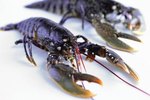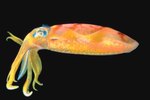
Cephalopods are a family of marine invertebrates whose members include octopus, squid and cuttlefish. There are more than 700 different species of cephalopods that have been identified. Although they're all unique and have their differences, all cephalopods have certain distinct characteristics in common.
Organs
All cephalopods have similarities in certain organs. They have three hearts, two of which move blood to the gills while the other pumps blood to the rest of the body. Their blood is blue, because it binds oxygen with the protein hemocyanin. Their brains are much larger than those of other invertebrates and most species are able to learn and remember information. They have two eyes, which are generally characterized as being extremely complex, perhaps even as sophisticated as the human eye.
Color
Cephalopods are able to change the color of their skin very rapidly and at will. They can even make intricate patterns and shapes on their skin. This is achieved using chromatophores, which are bags filled with pigment located in the skin. These chromatophores can be controlled by nerves to change the color of the skin. They primarily use this ability to help camouflage themselves, but it's also used as part of mating rituals.
Anatomy
All cephalopods have the same basic anatomy. They're made up of a body, a head and a foot. They have a muscular casing called a mantle which contains and protects their organs. They all have arms -- at least eight of them -- that are attached directly to their heads, but only some species also have tentacles. Their arms will either have cirri, suckers or hooks on their undersides.
Diet
Cephalopods are all strict carnivores. Exactly what they eat depends on the species and its size, but common prey includes various fish, crustaceans and mollusks. They have hard beaks, made out of horn, which are useful for tearing at and devouring their prey. While most species hunt for their food, there are certain species that prefer to scavenge for their meals.
References
Photo Credits
-
Comstock Images/Comstock/Getty Images




